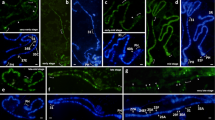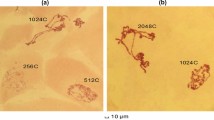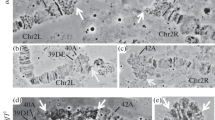Summary
-
1.
In salivary gland chromosomes of Drosophila melanogaster a markedly increased number of puffs appears at both the end of the last larval instar and the end of the prepupal stage (Fig. 1 and 2). Each of these puffing periods has its characteristic pattern of puff development with regard to the location of the puffs, their number and their sequence (Fig. 14). Puffs are considered to be active sites of their respective chromosomal loci.
-
2.
Experiments were designed to show whether puff formation depends upon the presence of metamorphosis hormones. The first step was the determination of the time of hormone production by the ring gland. To that end late third instar larvae were ligated in or near the fourth larval segment (Fig. 3). The ring gland lay in the portion anterior to the ligature, and the passage of hormones into the posterior portion was effectively prevented when ligating was performed prior to hormone production. If the anterior portion formed a puparium in less than 31/2 hours after ligating, the posterior portion also formed a puparium in all cases. If, however, puparium formation in the anterior portion set in more than 5 hours after ligating, the posterior portion remained larval in all cases (Table 3, Fig. 4 and 11). One can conclude, therefore, that 31/2–5 hours before puparium formation the ring gland produces the hormones that lead to this developmental step.
-
3.
A ligature in the above mentioned region of the larva has the additional effect of separating each salivary gland into two parts, one lying in the anterior and the other in the posterior portion. 58 such larvae were dissected at the beginning of puparium formation, and the chromosomes of the anterior and posterior parts of the glands were examined separately with regard to their puffing pattern. Whenever the anterior portion of a larva formed a puparium less than 4 hours after ligating then both the anterior and posterior portions of the salivary glands showed the puffing pattern which is characteristic for the end of the third larval instar (Table 6, Fig. 7, 8 and 11). If, on the other hand, puparium formation in the anterior part of a larva set in more than 5 hours after ligating, then only the gland portion contained in this part showed the typical puffing pattern, whereas the gland portion behind the ligature showed the larval pre-puffing-period chromosome structure (Table 7, Fig. 9–11.) Therefore the time between 4 and 5 hours before puparium formation appears to be a critical period for initiating of puff formation. From this close correlation between puparium formation and puffing it is concluded, that the puffing period in larval salivary gland chromosomes is triggered by the hormones of the ring gland.
-
4.
A comparison of the time span between hormone production and puparium formation with the assumed duration of the puffing period (about 4 hours) shows that the puffing reaction of chromosomes follows immediately on the production of hormones. This, in turn, supports the idea of a hormone-controlled gene activation without many intermediate steps. Finally, ring gland hormones seem to activate the complete gene pool provided for temporary salivary gland function, since the whole set of investigated puffs was affected by the ligating experiment.
-
5.
The cause for the difference between the puffing patterns in the third instar larva and in the prepupa was the objective of salivary gland transplantations. If a gland from an early third instar larva is transplanted into the abdomen of a late third instar larva (Fig. 16), both implant and host start with puff formation simultaneously, i. e. the implant reacts prematurely under the influence of the host milieu (Fig. 17 and 18).
-
6.
If a salivary gland of an early prepupa is transplanted back into the abdomen of a third instar larva, the puffing pattern of the implant shows characteristics of the host; i. e. section 78D of the implant chromosomes forms a puff under the influence of the host milieu (Fig. 19, 23 and 24). This puff is characteristic for the larva and normally does not appear in prepupal chromosomes (Fig. 14 and 20). The specificity of the puffing pattern, therefore, depends at least in part on the milieu which surrounds the gland. The milieu difference between the two puffing periods may well be due to a change of the relative amounts of the molting and the juvenile hormones.
-
7.
The results of both ligating and transplantation experiments are discussed in connection with previously available information. There appear to be two different attributes of the function of metamorphosis hormones with regard to gene activation : (a) they can trigger the activation of the gene pool, which a cell holds in preparation according to its state of differentiation, and (b) the milieu can select to a certain degree from the offered gene pool, possibly by means of changed relative amounts of hormones.
Similar content being viewed by others
Literatur
Becker, H. J.: Die Puffs der Speicheldrüsenchromosomen von Drosophila melanogaster. I. Mitteilung. Beobachtungen zum Verhalten des Puffmusters im Normalstamm und bei zwei Mutanten, giant und lethal-giant-larvae. Chromosoma (Berl.) 10, 654–678 (1959).
—: Variegation in the zeste eye color alleles and its bearing on gene action during the development of the eye of Drosophila melanogaster. Genetics 45, 519–534 (1960).
—: Stadienspezifische Genaktivierung in Speicheldrüsenchromosomen von Drosophila melanogaster. Verh. Dtsch. Zool. Ges. Saarbrücken 1961. Zool. Anz. Suppl. 25, 92–101 (1962).
Becker, E., u. E. Plagge: Über das die Pupariumbildung auslösende Hormon der Fliegen. Biol. Zbl. 59, 326–341 (1939).
Beermann, W.: Chromomerenkonstanz und spezifische Modifikationen der Chromosomenstruktur in der Entwicklung und Organdifferenzierung von Chironomus tentans. Chromosoma (Berl.) 5, 139–198 (1952a).
—: Chromosomenstruktur und Zelldifferenzierung in der Speicheldrüse von Trichocladius vitripennis. Z. Naturforsch. 7b, 237–242 (1952b).
—: Ein Balbiani-Ring als Locus einer Speicheldrüsen-Mutation. Chromosoma (Berl.) 12, 1–25 (1961).
Bodenstein, D.: Untersuchungen zum Metamorphoseproblem I. Kombinierte Schnürungs- und Transplantationsexperimente an Drosophila. Wilhelm Roux' Arch. Entwickl.-Mech. Org. 137, 474–505 (1938).
—: The role of hormones in molting and metamorphosis. In: Insect Physiology, Ed. K. D. Roeder, p. 879–931. New York: John Wiley and Sons 1953.
Breuer, M. E., and C. Pavan: Behavior of polytene chromosomes of Rhynchosciara angelae at different stages of larval development. Chromosoma (Berl.) 7, 371–386 (1955).
Bridges, C. B.: Salivary chromosome maps. With a key to the banding of the chromosomes of Drosophila melanogaster. J. Hered. 26, 60–64 (1935).
-, and K. S. Brehme: The mutants of Drosophila melanogaster. Carnegie Instn. Publ. 552 (1944).
Briggs, R., and T. J. King: Changes in the nuclei of differentiating endoderm cells as revealed by nuclear transplantation. J. Morph. 100, 269–311 (1957).
Burtt, E. T.: On the corpora allata of dipterous insects II. Proc. roy. Soc. B 126, 210–223 (1938).
Clever, U.: Genaktivitäten in den Riesenchromosomen von Chironomus tentans und ihre Beziehungen zur Entwicklung. I. Genaktivierungen durch Ecdyson. Chromosoma (Berl.) 12, 607–675 (1961).
—, u. P. Karlson: Induktion von Puff-Veränderungen in den Speicheldrüsenchromosomen von Chironomus tentans durch Ecdyson. Exp. Cell Res. 20, 623–626 (1960).
Ephrussi, B., and G. W. Beadle: A technique of transplantation for Drosophila. Amer. Naturalist 70, 218–225 (1936).
Fraenkel, G.: A hormone causing pupation in the blowfly Calliphora erythrocephala. Proc. roy. Soc. B 118, 1–12 (1935).
Hadorn, E.: An accelerating effect of normal “ring-glands” on puparium formation in lethal larvae of Drosophila melanogaster. Proc. nat. Acad. Sci. (Wash.) 23, 478–484 (1937).
—, u. J. Neel: Der hormonale Einfluß der Ringdrüse (Corpus allatum) auf die Pupariumbildung bei Fliegen. Wilhelm Roux' Arch. Entwickl.-Mech. Org. 138, 281–304 (1938).
Jacob, F., and J. Monod: On the regulation of gene activity. Cold Spr. Harb. Symp. quant. Biol. 26, 193–209 (1961).
Kaiser, P.: Histologische Untersuchungen über die Corpora allata und Prothoraxdrüsen der Lepidopteren in bezug auf ihre Funktion. Wilhelm Roux' Arch. Entwickl.-Mech. Org. 144, 99–131 (1949).
Karlson, P., u. Gisela Hanser: Bildungsort und Erfolgsorgan des Puparisierungshormons der Fliegen. Z. Naturforsch. 8b, 91–96 (1953).
Kiknadze, I. I., und T. Filatov: Funktionelle Änderungen des RNS-Gehaltes in den Zellen der Speicheldrüsen von Chironomus dorsalis während der Metamorphose. Nachr. d. Sibir. Abt. Akad. Wiss. UdSSR, 12, 131–134 (1961). [Russisch.]
King, T. J., and R. Briggs: Serial transplantation of embryonic nuclei. Cold Spr. Harb. Symp. quant. Biol. 21, 271–290 (1956).
Kopeč, S.: Experiments on metamorphosis of insects. Bull. int. Acad. Cracovie B, 57–60 (1917).
Kroeger, H.: The induction of new puffing patterns by transplantation of salivary gland nuclei into egg cytoplasma of Drosophila. Chromosoma (Berl.) 11, 129–145 (1960).
Mechelke, F.: Reversible Strukturmodifikationen der Speicheldrüsenchromosomen von Acricotopus lucidus. Chromosoma (Berl.) 5, 511–543 (1953).
—: Strukturmodifikationen in Speicheldrüsenchromosomen von Acricotopus als Manifestation eines Positionseffektes. Naturwissenschaften 47, 334–335 (1960).
Panitz, R.: Innersekretorische Wirkung auf Strukturmodifikationen der Speicheldrüse von Acricotopus lucidus (Chironomide). Naturwissenschaften 47, 383 (1960).
Piepho, H.: Über das Ausmaß der Artunspezifität von Metamorphosehormonen bei Insekten. Biol. Zbl. 69, 1–10 (1950).
—: Über die Lenkung der Insektenmetamorphose durch Hormone. Verh. Dtsch. Zool. Ges. Wilhelmshaven 1951. Zool. Anz. Suppl. 15, 62–76 (1952).
Possompès, B.: Recherches expérimentales sur le déterminisme de la métamorphose de Calliphora erythrocephala Meig. Arch. Zool. exp. 89, 203–364 (1953).
Rudkin, G. T., and P. S. Woods: Incorporation of H3 cytidine and H3 thymidine into giant chromosomes of Drosophila during puff formation. Proc. nat. Acad. Sci. (Wash.) 45, 997–1003 (1959).
Schurin, M. F.: Localized cytochemical and submicroscopic differentiations in Drosophila virilis salivary gland chromosomes. Genetics 44, 534 (1959).
Swift, H., and E. M. Rasch: Composition and structure of giant chromosomes. Int. Rev. Cytol. 3, 170–171 (1953).
Vogt, Marguerite: Die „Puparisierung“ als Ringdrüsenwirkung. Biol. Zbl. 62, 149–154 (1942).
—: Zur Produktion und Bedeutung metamorphosefördernder Hormone während der Larvenentwicklung von Drosophila. Biol. Zbl. 63, 395–446 (1943).
Author information
Authors and Affiliations
Additional information
Herrn Professor Friedrich Seidel aus Anlaß Scines 65. Geburtstages. — Mit Unterstützung durch die Deutsche Forschungsgemeinschaft.
Rights and permissions
About this article
Cite this article
Becker, H.J. Die Puffs der Speicheldrüsenchromosomen von Drosophila melanogaster. Chromosoma 13, 341–384 (1962). https://doi.org/10.1007/BF00327339
Received:
Issue Date:
DOI: https://doi.org/10.1007/BF00327339




